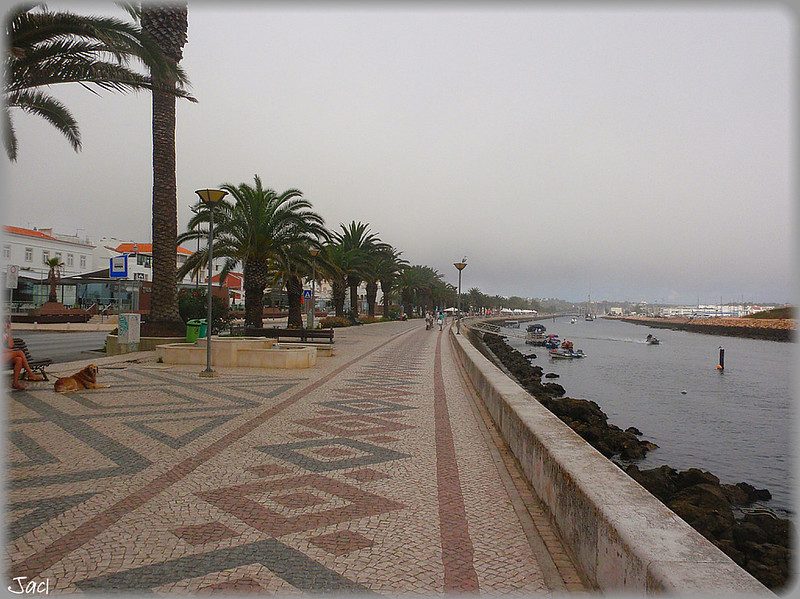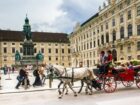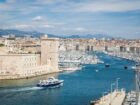If you’re planning to spend a couple of days or nights in the Algarve region South of Portugal, you may be wondering which of Faro or Lagos is a better choice for spending your time.
Table of Contents
Lagos vs Faro: quick answer

The capital of the Algarve, Faro is a relatively large (population around 65.000) working town that’s interesting to visit for a day or so for its authentic old town, historical buildings, and true Portuguese atmosphere. Lagos is much smaller (about half the population) and a pleasant seaside town surrounded with beaches. It has an animated touristic old center and an attractive riverfront. Faro, in contrast, does not have beaches per se.
If your main goal is to relax, walk around the beaches, and stroll around the lively touristic pedestrian streets enjoying the small bars and restaurants, Lagos is for you – assuming the weather is nice. On the other hand, if you like to be immersed in an authentic Portuguese town, live like the locals without a lot of tourist attractions except for a few monuments, you may like Faro for a day or two.
Lagos or Faro: access & transportation

Faro is very well connected to EU cities through its international airport. Many low-cost airlines fly there, being only 3.5 hours away from most major European cities. As a result, millions of visitors fly into Portugal through Faro each year, with many choosing to spend a night or two there before catching a bus to Seville or a train to Lisbon.
Being the regional capital of the Algarve, Faro has trains and buses to pretty much everywhere along the coast – eastbound toward Lagos, westbound towards Seville. There is a direct bus service from Faro to Spain (less than 1-hour drive) and Seville (2.5 hours). Faro is a 2.5-hour drive from Lisbon.
Lagos is further out West, closer to the West Coast of the Algarve (and Portugal). It’s not as well-connected and easily accessible. Some of the East-West buses and trains that go through Faro go all the way to Lagos. The ride between Faro and Lagos is about 2 hours by bus and nearly the same by train.
Traveling from Lisbon by train, you need to change in Tunes to get to Lagos (the train is direct to Faro). There’s also a direct bus from Lisbon.
Lagos or Faro: vibe & people

Lagos is a popular tourist resort town in the summer but has not been defaced with excessive construction and tourist attraction, like is the case for other Algarve cities (e.g. Portimao). It’s a Portuguese resort town where many Portuguese people have their summer quarters. The pedestrian old town still has its original Portuguese cachet even though many traditional stores have long been replaced by tourist shops and restaurants.
Faro, in contrast, has remained an authentic Portuguese city. This has both good and bad sides. On the one hand, there are way fewer gift shops and tourist traps than in Lagos, as Faro is primarily a working city. However, you may be surprised to see some old rundown buildings and fishermen’s cottages that look sort of abandoned.
Lagos, in contrast, is mainly whitewashed and renovated – the positive side of high tourist influx.
People in Faro are “normal” Portuguese working people. They are courteous to visitors but may appear quite reserved, even a bit distant at first. If you speak to them, however, they are typically very friendly and helpful.
The residents of Lagos are used to being invaded by tourists – particularly in the summer. As a result, you’ll find some nice and friendly locals as well as some protective ones who tend to avoid interactions. As is the case in many parts of the Algarve, the locals and the tourists are often two separate groups that don’t mingle except for commerce.
Lagos or Faro: sights & culture

Lagos has a pretty, renovated old town area with historic buildings that border on a narrow riverfront, the Bensafrim River. It has a modern marina with a large number of sailboats, a stunning oceanfront with high cliffs overlooking the sea and breathtaking sandy coves accessible by stairs for swimming and sunbathing.
There are quite a few cultural sights in the old Lagos for a town this size, as Lagos was the capital of the Algarve from the mid 16th to the mid 18th century. The 16th century walls, the slave market, the Santo Antonio Church (Portuguese national monument) and adjacent Lagos museum, are among the main historic sights. You can also visit the small Lagos Castle and fortress that overlook the Batata beach.
Faro’s old medieval town has more authentic sights including the old walls around the historic district, the impressive 13th-century Cathedral and its beautiful square, the massive Arco de Vila gateway, the episcopal palace, the old narrow paved streets… The Igreja Dos Carmos church shelters the Capela dos Ossos – an intriguing chapel whose walls are made from bones.
Walking around Faro feels traveling in the past. There are of course cafés, bars, and restaurants in some streets, even waiters standing outside with menus, but Faro, like the rest of Eastern Algarve, is much less affected by tourism than Lagos – which in turn is not as bad as some other resorts.
Lagos or Faro: nature & outdoors

Both Lagos and Faro offer a fantastic natural environment and great outdoor opportunities, though of different types. Lagos’ top attraction is its exceptional beaches and coves. The largest beach is Meia Praia across the river from the old town, easily accessible by foot over the river bridge. Porto de Mos is another long and popular beach bordered with small cliffs, with a couple of restaurants at one end.
Lagos also has a range of outstanding coves surrounded by high rocks and cliffs, such as Praia Batata and Praia do Pinhao right next to the old town. Other beautiful sheltered coves include Praia Dona Ana, Praia do Camilo, and the scenic Punta da Piedad point. In the warm season, you can swim, boat, kayak, or paddleboard around these coves and enjoy the transparent flat blue water.
Unlike Lagos, Faro is not really a beach holiday resort. It does have a nice and wide white sand beach but it’s located about 4 miles from the town near the airport, about a 15-minute drive (also accessible by ferry). Faro, however, is part of the Parque Natural da Ria Formosa, a natural reserve that protects a 60 km lagoon and a marsh system with dunes, small islands, and channels.

The park, considered one of Portugal’s seven wonders, shelters a wide variety of bird species, which makes it a very popular eco-tourism zone. You can go birdwatching on pedestrian trails or on boat/kayak/paddleboard trips along the Ria, e.g. with a nature guide. You can also take bicycle tours on the Ecovia do Algarve, a bike trail connecting the Algarve to the rest of Europe.
From Faro, you can also take a boat tour through the beautiful islands surrounding the town, and access gorgeous and desert beaches like Praia de Farol or Ilha Deserta.
In short, while Lagos has wonderful beaches and natural coves to offer, Faro has an attractive ecotourism offering for nature lovers.
Lagos or Faro: food, nightlife, shopping

Most of the restaurants and bars in Lagos are located in the old town near the riverfront, with a couple additional “tascas” on the opposite bank behind the marina – where locals like to hang out to escape the tourist crowd. There are also a few wood chiringuitos on the Meia Praia and Porto de Mos beaches which serve seafood and cocktails at medium range prices.
In Lagos, you’ll find all types of food, drinks, and prices. Petiscos is one of the popular restaurants with good Portuguese cuisine. There are also many pubs and bars with live music at night.
Faro has plenty of authentic restaurants, many of them with a lot of history and gourmet food offering. These include Mesa Dos Mouros, Faz Gostos, Ria Formosa (inside Hotel Faro), and Adega Nova. Similar to Lagos, most of the cocktails and wine bars in Faro are located in the old town and round the Ria waterfront.
Both Lagos and Faro have many small shops in their old town but the real shopping is done in large commercial malls outside the towns.
Lagos or Faro: lodging

In the summer season, prices in both Lagos and Faro climb a lot and many places are sold out. Both Faro and Lagos have decent hotels.
The Lagos Atlantic Hotel is highly rated for its great sea views and swimming pool. It’s a short walk from a beautiful beach (Praia de Porto Mos) and the cliff trails, and a short drive from the town center. Friendly staff, spacious rooms. Travelers appreciate the large patio and the jacuzzi.
There are also some good hotels around the Lagos marina including the well-regarded Hotel Marina Rio. A very nice hotel with balconies overlooking the marina, great big rooms, and a heated pool on the roof.
Just outside of Lagos, Quinta Bonita is also recommended by travelers. A small boutique hotel with comfortable rooms and great service, a 15-minute drive from the beaches and about 2 miles from the town center.
In Faro, Hotel AP Eva Senses (4 stars) and Hotel Faro & Beach Club, both 4-star hotels are often recommended. Both hotels are in the city center, close to the bus and train stations and to the marina.
Lagos or Faro: day trips

Lagos is the best base camp for exploring the Costa Vicentina on the West Coast, with its protected natural park and countless pristine beaches. This part is a surfer’s paradise with its great waves, but also offers beautiful countryside. You’ll need a car to drive along the South coast and up the West coast from Lagos.
On your way to the Costa Vicentina, you can make stops in the nice and small beach resorts of Luz, Burgau, and Sagres (near the Southwest point of Portugal). The area West of Lagos is mostly natural, unbuilt and agricultural, with fantastic beach villages and camping areas.

From Lagos, you can also drive West a few miles and visit the small beach resorts of Alvor and Carvoeiro, and the mass-tourism resort of Portimao with its huge Praia da Rocha beach. You’re also a short drive away from Silves and its spectacular Moorish castle.
From Faro, you can easily drive or take a bus to the other towns of central Algarve such as Olhao and Tavira to the East and Albufeira (another important summer tourist resort) to the West. If you have time, you can drive all the way to Spain and stroll around Ayamonte, the border town on the Guadiana river that has its own smuggler-laden charm.
Final words
Faro is an interesting and authentic city to visit with history and easy access to the beautiful nature of the Ria Formosa Park. It’s worth spending a day or two for walking around the quiet old town, dining in historical settings, and perhaps enjoying boat or bike trips around nature park.
Lagos has a lively yet historical all town with a nice number of places to eat and drink. The town’s main appeal is no doubt its stunning beaches and proximity to the Algarve’s unspoiled West coast. Travelers commonly choose to spend 4 or more days around Lagos.
***
Photo credits:
(1) Featured: “Lagos (Portugal)” (CC BY 2.0) by sky_hlv
(2) “Monumento a Dom Marcelino Franco – Tavir” (CC BY-SA 2.0) by Portuguese_eyes
(3) “Lagos (Portugal)” (CC BY 2.0) by sky_hlv
(4) “Faro, Portugal” (Public Domain) by ilyaplatonov
(5) “Lagos (Portugal)” (CC BY 2.0) by sky_hlv
(6) “Lagos, Portugal” (CC BY 2.0) by Michaela Fric
(7) “Ilha de Faro – Portugal” (CC BY-SA 2.0) by Portuguese_eyes
(8) “Lagos” (CC BY 2.0) by snaiwedu
(9) “Faro Portugal” (CC BY 2.0) by dronepicr
(10) “Portugal 059” (CC BY-SA 2.0) by Pat Neary
(11) “” (CC BY 2.0) by sergei.gussev




